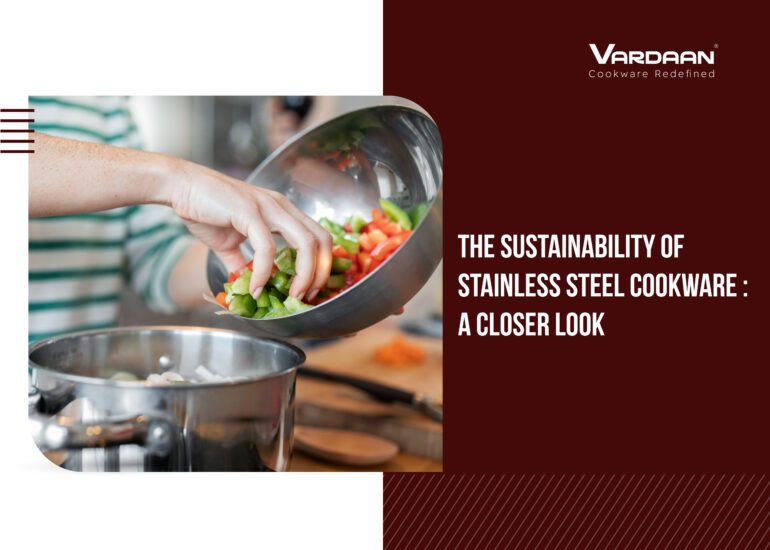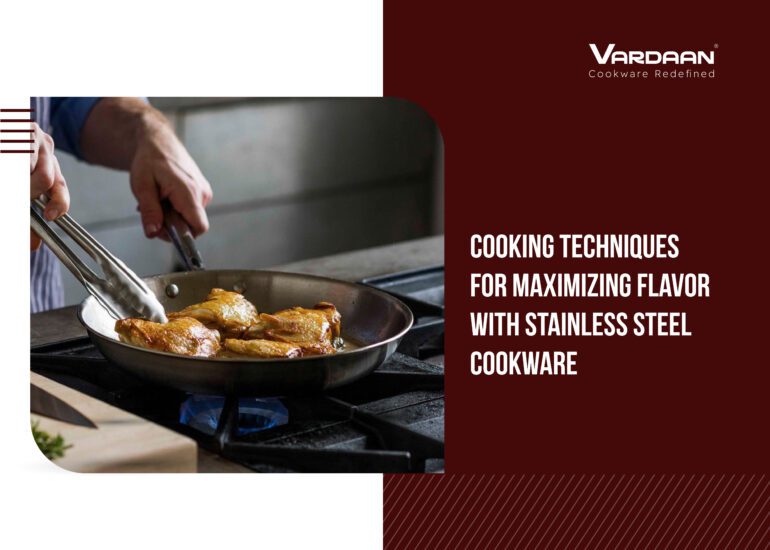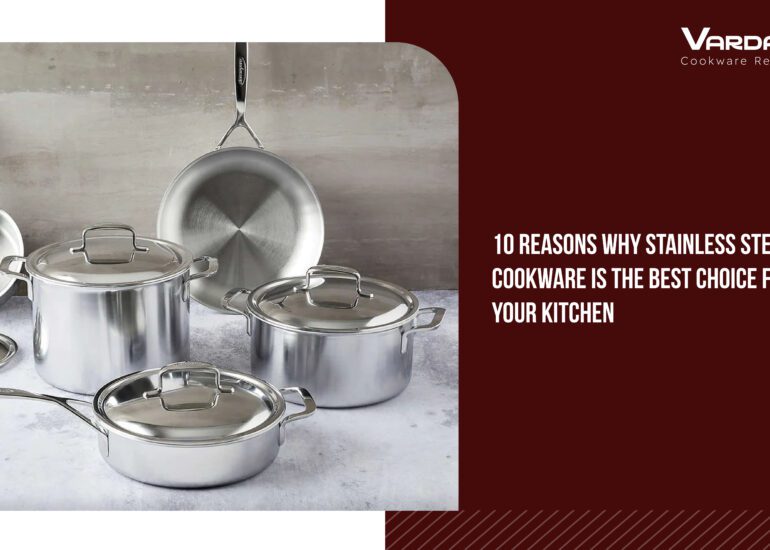Stainless steel cookware is a staple in modern kitchens, renowned for its durability and versatility. Composed of an alloy of steel, chromium, and sometimes nickel, stainless steel offers a non-reactive and non-corrosive cooking surface. This makes it ideal for healthy cooking, as it doesn’t leach harmful chemicals into food. Its popularity is attributed to its long-lasting nature, resistance to staining, and ease of maintenance. Stainless steel pans and pots are favored by both professional chefs and home cooks for their ability to evenly distribute heat and preserve the flavors of dishes. This cookware promotes a healthy cooking environment, allowing you to prepare delicious, wholesome meals with ease.
Benefits of Stainless Steel
- Durability: Stainless steel cookware is incredibly durable and long-lasting, making it a one-time investment that can serve you for years.
- Non-Reactive: It doesn’t react with acidic or alkaline foods, preserving the taste and quality of your dishes.
- Easy Maintenance: Stainless steel is resistant to staining, making cleanup a breeze.
- Even Heat Distribution: It ensures even heat distribution, preventing hot spots and allowing precise cooking.
- Eco-Friendly: Stainless steel is recyclable, contributing to a more sustainable kitchen.
- Versatility: It can be used for various cooking methods, from searing and frying to simmering and baking.
- Hygienic: It doesn’t harbor bacteria or odors, ensuring a clean cooking surface.
- Aesthetic: Its sleek and modern appearance adds a touch of elegance to your kitchen.
Healthy Cooking
Stainless steel cookware is an ideal choice for healthy cooking due to its non-reactive nature. Unlike some other materials, stainless steel doesn’t leach harmful chemicals into your food, ensuring that your dishes remain pure and uncontaminated. This is particularly important for health-conscious individuals who are concerned about the potential transfer of toxins from cookware to the meals they prepare.
With stainless steel, you can cook with confidence, knowing that the composition of your pots and pans won’t compromise the nutritional value and safety of your dishes. Its resistance to reacting with acidic or alkaline ingredients is a significant advantage, preventing unwanted substances from entering your food. This makes stainless steel a go-to option for those who prioritize healthy and wholesome cooking, allowing the natural flavors and nutrients of your ingredients to shine through.
Sustainable Cookware
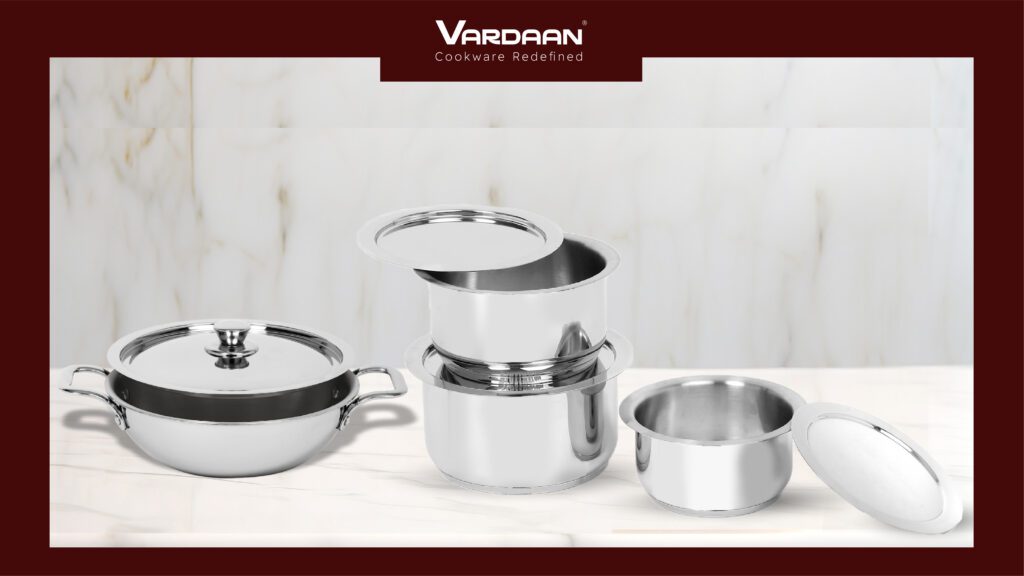
Stainless steel cookware is a sustainable choice for eco-conscious individuals. Its durability and long lifespan significantly reduce the need for frequent replacements, contributing to a reduction in waste. Stainless steel is resistant to rust, corrosion, and staining, ensuring it maintains its quality and appearance over time. This longevity means fewer resources are used in the production of new cookware, making it an environmentally responsible option. Additionally, stainless steel is fully recyclable, further reducing its impact on the environment. By investing in stainless steel cookware, you not only enjoy its many benefits but also make a positive contribution to sustainability.
Versatility in the Kitchen
| DISH TYPE | DISH EXAMPLES |
| Stir-Fries | Vegetable stir-fry, chicken stir-fry, tofu stir-fry |
| Soups and Stews | Tomato soup, chicken stew, lentil soup |
| Sauteed Vegetables | Garlic butter asparagus, sauteed mushrooms, mixed veggies |
| Curries | Chicken curry, vegetable curry, lamb curry |
| Rice Dishes | Biryani, pilaf, lemon rice |
| Pasta and Noodles | Spaghetti aglio e olio, stir-fried noodles, pasta primavera |
| Grilled Delights | Grilled fish, chicken breasts, vegetable skewers |
| Deep-Fried Snacks | Samosas, pakoras, French fries |
| Desserts | Chocolate fondue, caramelized fruits, rice pudding |
Stainless steel cookware’s versatility and durability make it suitable for a wide range of cooking techniques and dishes. Whether you’re sautéing, frying, simmering, or even baking, stainless steel is a reliable choice for all your culinary endeavors.
Seasoning and Maintenance
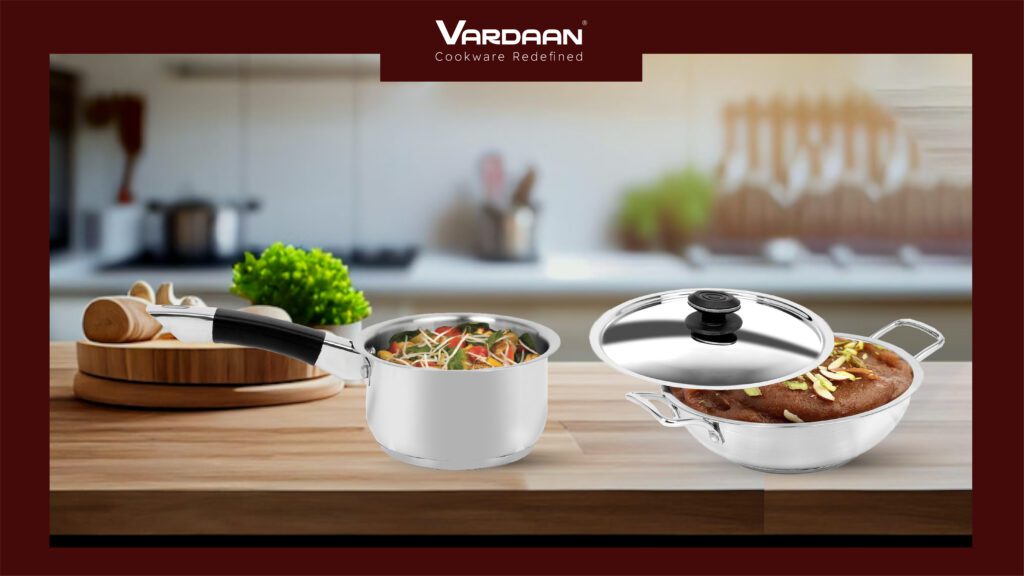
Seasoning and maintaining stainless steel cookware is essential for optimal performance. Here’s a guide to help you keep your stainless steel cookware in great condition:
Seasoning Stainless Steel Cookware:
- Wash and Dry: Before the first use, wash the cookware with warm soapy water and dry it thoroughly.
- Preheat the Pan: Place the pan on the stovetop over medium heat for a few minutes to ensure it’s completely dry.
- Add Oil: Once the pan is hot, add a high-heat cooking oil like vegetable oil or grapeseed oil. Use a paper towel to spread a thin layer of oil across the entire cooking surface.
- Heat and Cool: Heat the pan for about 5-10 minutes, allowing the oil to smoke slightly. This process opens the pores of the stainless steel. Then, let it cool down completely.
- Wipe Off Excess: Use a paper towel to wipe off any excess oil. Your stainless steel cookware is now seasoned and ready for use.
Maintaining Stainless Steel Cookware:
- Hand Wash: Always hand wash your stainless steel cookware with warm, soapy water. Avoid using abrasive scrubbers or harsh detergents, as they can damage the surface.
- Remove Stains: If stains or discoloration appear, mix a paste of baking soda and water. Apply it to the stained area, scrub gently, and rinse thoroughly.
- Avoid High Heat: Stainless steel can discolor when exposed to high heat. Use medium to medium-high heat settings for most cooking.
- Use Wooden or Silicone Utensils: Stainless steel is scratch-resistant but not scratch-proof. To prevent scratches, use wooden or silicone utensils.
- Dry Thoroughly: After washing, dry your cookware with a towel to prevent water spots and maintain its shine.
- Store Properly: When storing your cookware, use pan protectors or soft cloth between pots and pans to prevent scratching.
- Regularly Re-season: Over time, the seasoning may wear off. To maintain it, repeat the seasoning process as needed.
By following these steps, you can keep your stainless steel cookware in excellent condition and enjoy its benefits for years to come.
Cooking Techniques
Renowned chefs emphasize the significance of using stainless steel cookware for Indian cooking. Here are their expert tips on mastering Indian cooking techniques with stainless steel cookware, promoting sustainable and healthy cooking:
- Even Heat Distribution: Stainless steel’s ability to evenly distribute heat makes it perfect for Indian recipes that require precise temperature control. Renowned chefs recommend using stainless steel to achieve perfect curries, gravies, and crispy dosas.
- Dry Roasting: For spices and seeds often dry-roasted in Indian cuisine, stainless steel pans are a top choice. Their even heat helps release the full flavor and aroma of ingredients, such as cumin, coriander, and mustard seeds.
- Non-Reactivity: Stainless steel cookware is non-reactive, preventing the absorption of flavors or odors from one dish to another. This is especially beneficial in Indian cooking, where various spices and aromatics are used.
- Durability: Indian cuisine includes dishes with a rich, complex blend of flavors. Stainless steel’s durability ensures longevity, even with the frequent stirring, simmering, and sautéing common in Indian recipes.
- Easy Maintenance: Stainless steel cookware is easy to clean and maintain, an essential aspect of Indian cooking that involves a variety of ingredients and spices. Stainless steel’s resistance to staining and discoloration is a valuable feature.
- Eco-Friendly Choice: Chefs appreciate stainless steel’s eco-friendliness due to its longevity and recyclability. It’s a sustainable choice for those concerned about the environment.
Incorporating stainless steel cookware into your Indian cooking routine can elevate your dishes and help you achieve authentic flavors while prioritizing sustainability and health. Renowned chefs worldwide recognize the advantages of stainless steel for Indian cuisine, making it a preferred choice for both home and professional kitchens.
Kitchen Organization
Stainless steel containers play a vital role in creating a well-organized kitchen. Here are some insights into how they contribute to kitchen organization:
- Durability and Longevity: Stainless steel containers are built to last. They withstand wear and tear, making them a long-term investment. You won’t need to frequently replace them, contributing to a clutter-free kitchen.
- Versatility: Stainless steel containers come in various sizes and shapes, allowing you to organize and store different food items efficiently. They are versatile for storing anything from dry goods like grains, cereals, and pasta to liquids like soups and sauces.
- Airtight Sealing: Many stainless steel containers come with airtight lids. This feature preserves the freshness and quality of your ingredients, reducing food waste, and ensuring organized, well-maintained kitchen storage.
- Stackability: Stainless steel containers are often designed to stack neatly, optimizing your storage space. They allow you to utilize your kitchen cabinets and pantry shelves efficiently.
- Easy Maintenance: Cleaning stainless steel containers is a breeze. Their smooth, non-porous surfaces don’t absorb odors, stains, or flavors, promoting a hygienic and organized kitchen.
- Easy Labeling: Stainless steel containers often have smooth surfaces suitable for labeling. You can use labels or erasable markers to identify what’s inside, making it easier to find the ingredients you need.
- Elegant and Timeless Design: Stainless steel containers’ sleek and modern design adds a touch of elegance to your kitchen. Their timeless appearance compliments various kitchen decors and styles.
- Resistance to Stains and Odors: Stainless steel’s non-reactive nature means it won’t absorb or transfer stains, odors, or flavors from the stored food, ensuring the integrity of your ingredients.
By incorporating stainless steel containers into your kitchen organization strategy, you can enjoy a clutter-free and well-organized culinary space. Their durability, versatility, and practical features make them essential tools for efficient cooking and meal preparation.
Sustainable Kitchen Practices
Zero-waste kitchen habits are not only eco-friendly but also align with the use of sustainable cookware like stainless steel containers. Here are some practices to reduce waste and promote sustainability in your kitchen:
- Meal Planning: Planning meals in advance reduces food waste. Stainless steel containers are excellent for storing meal-prepped items, keeping them fresh and ready for consumption.
- Reducing Single-Use Plastics: Stainless steel containers serve as eco-friendly alternatives to single-use plastic containers and bags. By using them for storage, you significantly reduce plastic waste in your kitchen.
- Composting: To minimize food waste, establish a composting routine for kitchen scraps. Stainless steel containers can be used to collect compostable materials before transferring them to your compost bin.
- Bulk Buying: Purchase food items in bulk and use stainless steel containers to store them. This not only minimizes packaging waste but also saves money in the long run.
- Reusable Produce Bags: Instead of disposable plastic bags, opt for reusable produce bags made from sustainable materials. These bags can be easily stored in your stainless steel containers.
- Sustainable Utensils: Use stainless steel utensils and kitchen tools, which are durable and long-lasting. They reduce the need for replacing single-use plastic utensils.
- Efficient Food Storage: Stainless steel containers provide an airtight and moisture-resistant seal, ensuring your food stays fresh for longer, which reduces the chances of food spoilage.
- Eco-Friendly Cleaning: Choose sustainable and non-toxic cleaning supplies for your cookware and kitchen. This further aligns with eco-conscious practices.
By embracing these zero-waste kitchen habits alongside sustainable cookware, you can reduce your environmental impact, promote healthy cooking, and create a kitchen that’s both eco-friendly and well-organized. It’s a win-win for you and the planet.
Cleaning and Maintenance
- Hand Wash: While most stainless steel cookware is dishwasher safe, handwashing with mild soap and warm water is gentler on the surface and prolongs its shine.
- Avoid Abrasives: Don’t use abrasive sponges or harsh scouring pads that can scratch the stainless steel. Instead, opt for soft cloths or non-abrasive scrubbers.
- Soak Stubborn Stains: For stubborn stains, soak the cookware in a mixture of vinegar and water or use a specialized stainless steel cleaner.
- Dry Thoroughly: After washing, ensure the cookware is completely dry to prevent water spots or discoloration.
- Use Baking Soda: To remove tough stains or discoloration, create a paste with baking soda and water, apply it to the affected area, and gently scrub.
- Season Stainless Steel: Similar to cast iron, you can season stainless steel by applying a thin layer of cooking oil and heating it until it starts to smoke. Allow it to cool, then wipe off excess oil. This enhances its non-stick properties.
- Regularly Polish: To maintain its shine, periodically polish stainless steel with a stainless steel cleaner or a mixture of water and vinegar.
- Prevent Heat Stains: To avoid heat stains, never place empty stainless steel cookware on high heat. Add oil or food before heating.
- Stack Carefully: If you stack your cookware, place a soft cloth or paper towel between pieces to prevent scratching.
- Store Properly: Store cookware with lids off to allow air circulation and prevent moisture buildup.
Following these tips will help keep your stainless steel cookware in top condition, ensuring its longevity and performance for years to come.
Global Kitchen Trends
Sustainable kitchen practices, like using stainless steel containers for eco-friendly food storage, serve as a cornerstone for greener living. By reducing single-use plastics and minimizing food waste, we not only benefit the environment but also inspire eco-conscious choices throughout our homes. This mentality extends to energy-efficient appliances, water conservation, recycling, and reducing overall household waste. Sustainable kitchen organization not only streamlines meal preparation but also encourages mindful consumption and purchasing. In essence, eco-friendly kitchen habits are a catalyst for a more sustainable, greener lifestyle that values environmental responsibility and resource preservation, making a positive impact on our world for years to come. Explore sustainable kitchen solutions here.


